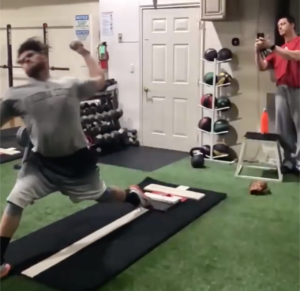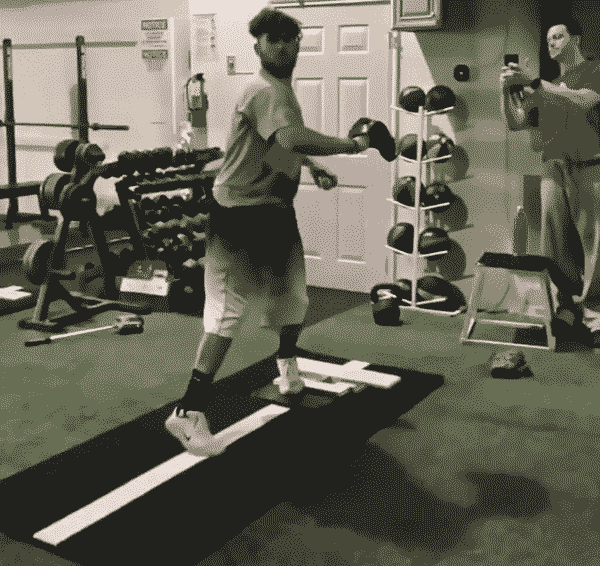 The conventional pitching coach will spend most of his time working with a pitcher's body positions, like torso alignment or arm angle, instead of his speeds. Pitching velocity is influenced more by the speeds of the body movements than its Kinematics. Kinematics are very important to pitching but without a complete understanding of its relationships to the forces and speeds of the movements then the ability of a pitching coach or a pitcher to have a significant effect on enhancing pitching velocity is limited.
The conventional pitching coach will spend most of his time working with a pitcher's body positions, like torso alignment or arm angle, instead of his speeds. Pitching velocity is influenced more by the speeds of the body movements than its Kinematics. Kinematics are very important to pitching but without a complete understanding of its relationships to the forces and speeds of the movements then the ability of a pitching coach or a pitcher to have a significant effect on enhancing pitching velocity is limited.
Speed Mechanics is the heart of 3X Pitching. It defines the importance of speed through the kinetic chain as it relates to pitching velocity. It tends to be overlooked by the conventional coaches and pitchers who learn the 3X approach to increase pitching velocity for the first time because they focus more on the kinematics aka 3X Mechanics. The problem is most of these coaches and pitchers do not see themselves or the pitcher as speed or power athletes. It takes a completely new perspective for these conventional coaches and pitchers to see high velocity pitching as a speed movement and not just a series of positions. This article will help prove once again the importance of speed to pitching velocity.
Scientific Proof that Speed is the Dominate Link to Pitching Velocity
 If you spend anytime at one of the 3X Velocity Camps or training with the Pitchers at my baseball pitching facility, you will hear me say a few hundred times, "You can never have enough speed!" Setting a goal to increase your pitching velocity really has no limit. If you could throw 150 mph you would do it, so this is proof that you must always be working to produce more speed because you can never produce enough.
If you spend anytime at one of the 3X Velocity Camps or training with the Pitchers at my baseball pitching facility, you will hear me say a few hundred times, "You can never have enough speed!" Setting a goal to increase your pitching velocity really has no limit. If you could throw 150 mph you would do it, so this is proof that you must always be working to produce more speed because you can never produce enough.
A recent case study performed at the Department of Health, Kinesiology, Recreation, and Dance, University of Arkansas, Fayetteville, Arkansas, has proven that speed or the rate of rotation was the connection between the torso and the shoulder parameters of baseball pitchers and that the kinematics of the pelvis and torso had no relationship to the shoulder parameters listed. The study was called, Pelvis and torso kinematics and their relationship to shoulder kinematics in high-school baseball pitchers. Here are the results from the study:
Results indicated that for several parameters, the actions at and about the shoulder are strongly related to the actions of the pelvis and torso throughout the pitching motion. However, although pelvis and torso kinematics throughout the pitching motion were inversely related to both shoulder elevation and the plane of shoulder elevation, only the rate of axial torso rotation was significantly related to these shoulder parameters. More importantly, the rate of axial torso rotation is significantly related to these shoulder parameters in a way that may help explain the high rate of shoulder injury in high-school pitchers. Therefore, strength training should focus on developing a strong stable core including the gluteal musculature in an attempt to control the rate of torso rotation during the pitch.
Read the entire study here: http://www.ncbi.nlm.nih.gov/pubmed/20703168
This case study proves that shoulder abduction and optimal external rotation which is a high velocity component, is not related to the positions a high velocity pitcher puts his arms and shoulders in. It is related to the speeds of his torso movements which is driven by his core and gluteal musculature as stated in the case study above.
The case study listed in the previous article called, The Superior Cuban Fastball Revealed, stated that Cuban pitchers had higher velocities out of all the other Olympic Countries and the key component that the Cuban's had, which stood out from all of other countries, was that shoulder abduction was greater during arm cocking and acceleration. The study listed above, along with this study of the Olympic pitchers from the previous article, would prove that these Cuban pitchers must have had a higher rate of torso rotation than the other countries. In the case of Aroldis Chapman, the Cuban phenom, this hypothesis would be true but more evidence is still needed.
Speed Mechanics Supports Pitching Velocity and a Healthy Arm
There isn't one case where speed is a problem with power pitching. Speed is what separates low velocity pitchers from high velocity pitchers. Claiming that high velocity pitchers have more hip to shoulder separation than low velocity pitchers is true but this enhanced separation must be the product of more speed. Therefore it is more accurate to say that high velocity pitchers move faster than low velocity pitchers within the proper kinematics. This is the foundation of Speed Mechanics and 3X Pitching.
Another important part of the first case study listed above was the claim that torso speeds may support healthier arms. If you read my recent article called, Research Proving Pronation Supports Pitching Velocity While Preventing Injury, you would understand that more hip to shoulder separation and shoulder elevation will promote accelerated external to internal rotation and pronation of the throwing arm which will reduce valgus loads on the elbow. This will help reduce the chances of damaging the UCL which can result in Tommy John surgery.
This article has hopefully helped to make the point that speed must never be overlooked. It must always be the foundation of power pitching and even proper pitching mechanics to help prevent injury. If more pitching coaches and young pitchers understood this essential factor in the pitching delivery then there would be more high velocity pitchers in the game and also less arm injury at all levels of the game.


great information, when i come up i will be hoping to enhance my mechanics using my new gained speed!
50 inch box jump PR with 25 lb vest!
like we talked about funny reading my post prior to the camp where my vertical was 24
still pulling to get that 1.5x BW